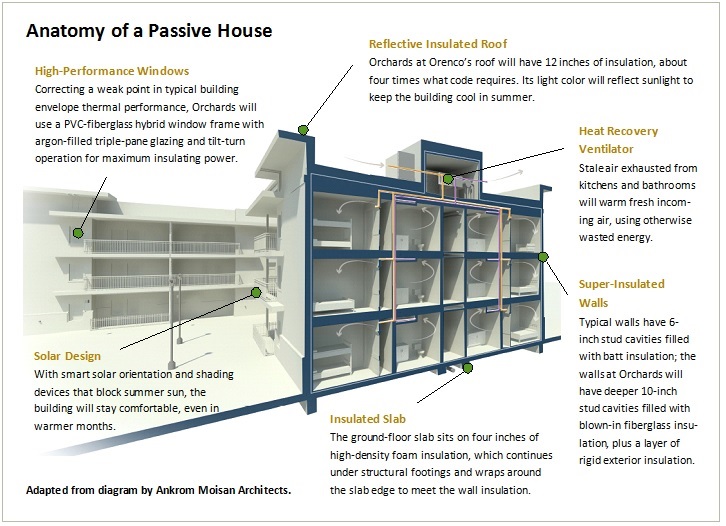HDC Senior Project Manager Craig Kelley talks about developing one of the largest affordable Passive House projects in the world.
Portland, OR – April 7, 2015 – (RealEstateRama) — When complete this summer, REACH Community Development’s Orchards at Orenco (Phase One) will provide affordable homes for 57 low-income families and individuals in Hillsboro—and will raise the bar, internationally, for energy performance in affordable multifamily housing. Here, HDC Senior Project Manager and green building expert Craig Kelley, who coordinated energy incentive funding for Orchards at Orenco and is managing construction, talks about the challenges and rewards of working on this highly innovative project.
What makes Orchards at Orenco unique? Orchards at Orenco is the largest multifamily Passive House building to break ground in North America, and one of the largest affordable Passive House projects in the world.
How do you define Passive House, in a nutshell? Passive House is an energy standard that came out of Europe, which looks at key benchmarks for the heating energy for a building, the total energy for a building, and air tightness, and sets performance metrics for those. Then it’s up to the team, design and construction, to meet those benchmarks through whatever design and construction methods they choose. The result, we hope, will be a building that uses up to 80% less energy than a similar building constructed to code.
[Below: Craig leads the Housing Development Center board on a tour of the Orchards at Orenco construction site.]
Why take on this challenge? The vision and commitment came from REACH Community Development. REACH has a goal of providing not just affordable housing, but also “affordable living” opportunities—which means reducing the total cost to residents of rent, utilities, transportation and food. After seeing Passive House projects in Europe, REACH’s former executive director got excited about bringing the idea to the U.S., and REACH included it as a goal in its current five-year strategic plan.
What about from HDC’s perspective? For HDC, it’s an extension of our leadership in green building and energy efficiency. It’s a very, very innovative building, and it’s fun and challenging to take on innovation. I also see a lot of potential benefit in finding cost effective strategies for improving energy performance that can be replicated across future projects for REACH and for other clients.
Where do you start with the process of creating a building that meets these ambitious standards? We started with looking at the design of the building. One of the most important things our team did was to begin the design process with a goal of meeting Passive House standards, rather than layering Passive House ideas on top of a typical affordable housing project.
So, we looked at the solar orientation and massing of the building. We took a critical look at how to optimize the window-to-wall ratio—the amount of glass you have versus the amount of opaque insulated wall—in order to provide nice day-lighting for residents while also reducing energy loss and materials cost (because the cost of glazing is significantly more expensive than the cost of an insulated wall). Working with the architect and contractor, we looked at five different wall assemblies to find one that not only had an R value of 43—double the insulation that code requires—but also was the most cost effective, the most constructible and the least susceptible to moisture issues.
You’re looking at long-term maintenance and repair costs, then, not just construction costs? Correct. I think this is one of the aspects of green building that doesn’t get as much attention as it deserves. You need to look carefully at the durability of materials, and the performance of systems, as well as repair-ability. An example at Orchards is that the windows are inset into brick on the first floor. Brick is going to last 75 to 100 years, while the windows may last only 25 to 30 years. But the way the windows are being installed, they can be replaced from the inside rather than having to remove any brick around the outside of the windows. Small things like that make a building last longer and be more affordable, not only to the residents but also to the owners.
Did you have to get creative with funding? Certainly. There’s a cost to innovation, and I think REACH recognized that going in. The analysis that we’ve done is that we’re paying probably an 11% premium above a typical affordable housing building. It was important to REACH and to HDC that that premium not be paid for out of scarce public resources. So, to pay for those incremental costs, the project was able to use some equity from REACH, as well as some innovation-focused grant dollars—sources that typically wouldn’t come into affordable housing. One of HDC’s roles, and a big part of my work, was to coordinate additional funding support around some of the energy components. Also, the tax credit investor paid a small premium for the purchase of the tax credits, which was used toward the Passive House goal.
How replicable is this funding model? That’s a question REACH is addressing with the second phase of the Orchards project—another 58 units on the same site. We’re looking at how we can take some of the most cost effective measures from Phase One and replicate those, given new cost containment limits from funders. The way we’re looking at it, Phase One was about innovation, and Phase Two is about figuring out how to implement some of those best practices going forward, when you don’t have innovation-focused grant sources available.
What are the biggest technical challenges you’ve faced in trying to meet Passive House benchmarks? The biggest challenge has been developing air barrier detailing to meet the air tightness requirements. The air change requirement is 0.6 air changes at 50 pascals; the code when the building was permitted was five air changes per hour, so we’re basically aiming at 10% of current code.
What’s an example of where that detailing comes into play? We had to find commercial exterior doors that not only meet air tightness requirements, but also have the capacity for electric hardware—security access controls and an ADA [Americans With Disabilities Act] door operator—as well as sills that meet strict federal accessibility standards. Because of the federal housing dollars in the project, we need to meet UFAS, Uniform Federal Accessibility Standards, which are stricter than ADA. We eventually selected an American made, thermally broken, triple-pane glass storefront door. These doors will not be as airtight as European models but will accept standard hardware and access controls and have a UFAS–compliant sill.
We also have interior spaces that require tight air sealing, and those doors have to be able to take electric hardware and also have a fire rating on them. Our solution for that has been to have custom doors built by a manufacturer in New York. This example speaks to how the market in North America just hasn’t caught up with some of the products that are needed to build a building of this scale. Hopefully we’re pushing the market a little bit.
You’ve talked about design, product sourcing and financing issues. Now that the project is more than halfway through construction, are you facing different challenges? Yes, I honestly think the biggest challenge on the project will be air testing, which has yet to come. We’ve designed the project with the target of meeting Passive House air infiltration requirements, but actually constructing the building this tightly is going to be exceptionally challenging. [Update from Craig: “The preliminary blower door testing achieved 0.075 air changes per hour at 50 pascals of pressure (ACH50), which is well below the 0.6 ACH50 Passive House requirement, and orders of magnitude below the code target of 5 ACH50.”]
The building is scheduled to open in June. When residents and visitors walk inside, will they notice things that feel or look different from a typical building? I think those things will be fairly subtle. The walls will be exceptionally thick, which you’ll see if you look at a windowsill or door opening. Because of the lack of air infiltration, you won’t get any draftiness around windows, and you won’t lose heat, including radiant body heat, through the triple-pane windows. The units will have continuous ventilation in the kitchens and bathrooms, which will exhaust humidity from showers and cooking, as well as odors. There will be more air changes in a unit over the course of a day than would be typical, which will improve the air quality. And even though the building is located adjacent to a MAX line, I think the triple-pane windows, combined with the additional insulation, will keep the units exceptionally quiet.
How will Orchards differ from projects built to better-known green building standards? Compared to standards such as a LEED Platinum or Net Zero, Passive House is a little more understated, as the name implies. The benefits come from things that are more out of sight, rather than from a big photovoltaic array or “green bling.” There’s an energy consultant who worked for the Oregon Department of Energy; he used the expression, “You have to eat your conservation vegetables before you can have your renewable cookies.” We have a lot of conservation vegetables on this project. They may not be really sexy or apparent, but they will add value for REACH and residents.
What advice would you give to someone who’s considering embarking on a project similar to this? There are a couple of key decision points. One is to start with the goal of meeting Passive House benchmarks and being flexible about how you accomplish that. Maybe you have slightly lower performing windows, which means you have slightly higher requirements for insulation; but that’s a good tradeoff, because you know those windows are going to perform and be durable and high quality. You have to look at how all those aspects and components interact with each other.
The other key thing is selecting the right team—having an architect, contractor, structural engineer and Passive House consultant who will help you meet your goals. The structural engineer on this project has really been essential to understanding how the structural details impact energy performance, and how it might take nontypical structural details to eliminate thermal bridging or simplify construction. And you need a really good Passive House consultant, who is willing to look at a bunch of different scenarios and iterations, and to be flexible to how you meet the Passive House metrics.
You’ve been doing green building for awhile… I did my undergraduate thesis on green building in the ’90s, so 20-plus years, yes.
How does this project rate in the pantheon of green building job experiences you’ve had? It’s exciting, working on this bleeding-edge project with a bunch of very smart people who are committed to reaching a very high bar. We’ve got a great team, both technically and in terms of their individual personalities. Trying to solve problems and come up with creative ideas and solutions has been fun, and a learning opportunity. It’s also been very challenging and time consuming, but I hope that the investment of time and intellectual capital results in a great building for REACH and their residents. I also hope this project informs future REACH projects and the broader industry on how to push energy efficiency and comfort in a way that benefits residents as well owners.
Learn more about Orchards at Orenco here.





